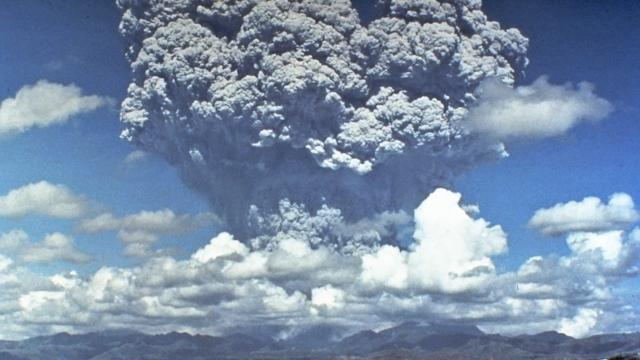The cooling effects of large volcanic eruptions have led some scientists to believe these natural hazards could inspire and inform the development of geo-engineering schemes to combat climate change. New research suggests this is probably a bad idea.
Our planet may soon pass a critical tipping point, after which time a massive reduction of carbon emissions is still unlikely to swing the climate tide. Hence the uncomfortable conversations we’re starting to have about the prospect of developing and deploying technological hacks to fix our troubled atmosphere. Various geoengineering schemes have been proposed over the years to cool the Earth, but one possible solution owes its inspiration to a well known natural phenomenon: large volcanic eruptions.
Big eruptions can spew copious amounts of ash into the atmosphere. The resulting blanket of floating particles reflects some of the sun’s radiation back into space, creating a cooling effect on the surface, which lasts until the ash falls back down to the ground. That’s led some scientists to study eruptions as a possible proxy for solar geoengineering schemes that would block incoming sunlight by delivering massive amounts of sulfate aerosols into the lower atmosphere.
But the new research published in Geophysical Research Letters suggests that the effects of volcanoes are likely to be vastly different than those created by solar geoengineering schemes.
For the new study, Ken Caldeira from the Department of Global Ecology at the Carnegie Institution, and his colleagues explicitly sought to test the assumption that volcanoes are good analogues for solar geoengineering schemes involving stratospheric sulfate aerosols.
Caldeira and his team used computer models to compare the atmospheric effects of a volcanic eruption to the effects of solar geoengineering. Both models applied similar principles, namely the mass distribution of aerosols into the Earth’s lower atmosphere. The difference, however, is that volcanoes deliver particles of ash during the course of a single eruption, which the researchers describe as “pulsed emissions.” Geoengineering schemes, on the other hand, would involve the steady release of aerosols such that they’d linger in the atmosphere for years, a process described as “sustained emissions.”
Results of the simulations showed that, regardless of pulsed or sustained emissions, Earth’s surface would experience a rapid decrease in temperature. Land surfaces, in particular, would cool a bit faster than ocean surfaces. But that’s the extent of the similarities.
Simulated volcanic eruptions produced greater temperature discrepancies between the land and sea compared to geoengineering simulations. In turn, this affected the water cycle, resulting in discernable differences in weather patterns. Both simulation types resulted in decreased precipitation over land, providing less water to people living in the affected regions. But this precipitation decrease was more pronounced following a simulated volcanic eruption.
Writing in the new study, the authors posited a reason for the observed differences:
Relative to the Sustained case, the Pulse case has much larger reductions in surface temperature over land. This greater cooling over land leads to a larger decrease in the upward motion of air over land in lower atmosphere and reduces water vapour transport from the ocean to land. As a result, for similar amounts of cooling, the decrease in land runoff [precipitation] caused by a short‐term pulse aerosol forcing is about twice as large as that caused by a sustained aerosol forcing [i.e. emissions].
The differences observed between the pulsed and sustained emissions “clearly show that caution should be taken when using climate consequences of volcanic eruptions to directly infer climate responses to stratospheric aerosol geoengineering,” the authors concluded in the study. That said, “observations and simulations of climate impacts from volcanic eruptions test many of the same physical mechanisms that would come into play in a stratospheric aerosol geoengineering scenario, and thus, volcanoes remain as valuable tests of models used to simulate solar geoengineering deployment,” the authors wrote.
It’s important to point out, and as the researchers themselves admit, the simulations were “highly idealised” models of the real world. That is, they used simplified versions of reality in order to compare the effects of volcanic eruptions and solar engineering. For example, the researchers didn’t consider aerosols of different sizes, nor did they consider different types of aerosols. They also didn’t consider the latitude of the volcanic eruption, the time of year of the eruption, and so on. Despite these limitations, the researchers insist their models are decent reflections of how volcanic eruptions and solar engineering might affect global surface temperature and the water cycle.
“Nobody likes the idea of intentionally tinkering with our climate system at global scale,” said Caldeira in a press release. “Even if we hope these approaches won’t ever have to be used, it is really important that we understand them because someday they might be needed to help alleviate suffering.”
Clearly more work is needed in this area, including more robust and diverse simulations. We can’t immediately discard the prospect of geoengineering so finding good testing platforms remains an open challenge. In the meantime, and as Caldeira aptly pointed out in the press release, “the best way to reduce climate risk is to reduce emissions.”
